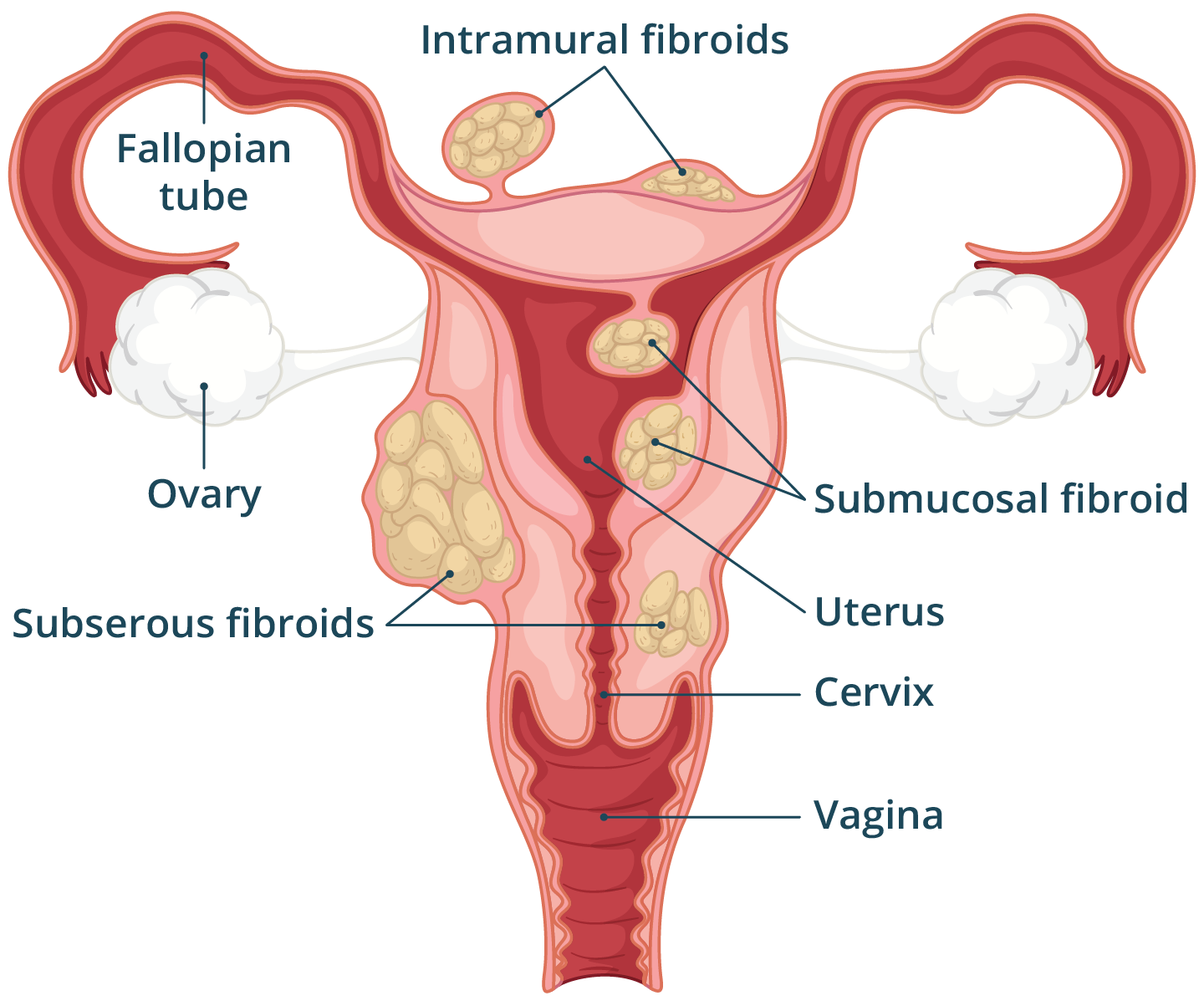Uterine fibroids
Key facts
- Fibroids are non-cancerous growths in the muscle layer of your uterus (womb).
- Fibroids are common and can cause painful and heavy periods.
- Most fibroids do not need treatment.
- If treatment is needed, your options depend on your symptoms, the type of fibroid you have and whether you want to get pregnant in the future.
What are fibroids?
Fibroids are non-cancerous growths in the muscle layer of your uterus (womb). Fibroids are very common. They are also known as myomas.
Fibroids can vary in size, from being tiny to being the size of a melon. It's possible to have one or many fibroids.
There are different types of fibroids, based on where they grow in your uterus.
- Subserous or subserosal fibroids grow on the outer wall of the muscle layer.
- Intramural fibroids grow within the muscle wall of your uterus.
- Submucosal fibroids grow on the inner wall.
Pedunculated fibroids are a type of fibroid that grow on a stalk.

What are the symptoms of fibroids?
Fibroids are usually small and don't cause any symptoms.
When uterine fibroids do cause symptoms, they include:
- heavy periods
- long-lasting periods
- bleeding between periods
- period pain
Other symptoms can include:
- pain or pressure in your pelvis or lower back
- painful sex
- needing to urinate (wee) a lot
- constipation
Symptoms from fibroids usually get better after menopause.
CHECK YOUR SYMPTOMS — Use the Symptom Checker and find out if you need to seek medical help.
What causes uterine fibroids?
The cause of uterine fibroids is unknown. However, the female hormones oestrogen and progesterone have been linked to the growth of fibroids.
Fibroids usually develop during your reproductive years. They may shrink after menopause.
When should I see my doctor?
See your doctor if you have:
- pelvic pain or symptoms
- heavy periods
- abnormal vaginal bleeding
- been having difficulty getting pregnant
FIND A HEALTH SERVICE — The Service Finder can help you find doctors, pharmacies, hospitals and other health services.
How are uterine fibroids diagnosed?
Your doctor will ask about your symptoms and general health. They will examine you and may ask to do an internal examination.
Tests that can help diagnose fibroids include:
- a pelvic ultrasound scan
- a vaginal ultrasound scan
- another type of scan, such as an MRI scan
Your doctor may refer you to a specialist gynaecologist for more tests, such as:
- a hysteroscopy, where a thin telescope is used to examine the inside of your uterus
- a laparoscopy (keyhole surgery), where a thin telescope is inserted through a small cut in your abdomen (tummy) to look at your reproductive organs
ASK YOUR DOCTOR — Preparing for an appointment? Use the Question Builder for general tips on what to ask your GP or specialist.
How are uterine fibroids treated?
Uterine fibroids don't always need to be treated. Treatment may be recommended if you have:
- symptoms that are bothering you
- complications
If treatment is recommended, the type of treatment will depend on:
- your symptoms
- the type, size and number of fibroids you have
- your age
- whether you want to become pregnant in the future
There are several different treatment options.
Medical treatments
Medicines and hormone treatments can be given to:
- shrink your fibroids
- treat your symptoms
They can include medicines, implants and intra-uterine devices.
Procedures or surgery
Surgery or other procedures can be done to shrink or remove your fibroids. These include:
- High-intensity focused ultrasound treatment, which uses ultrasound waves to shrink your fibroids.
- Uterine artery embolisation, which can shrink your fibroids by blocking their blood supply.
- Surgical removal of fibroids, called a myomectomy. This can be done during a hysteroscopy or laparoscopy.
- A hysterectomy (removal of your uterus) — usually only for those who have completed their family or do not wish to have children.
Can fibroids be prevented?
There is currently no known way of preventing fibroids.
Complications of fibroids
Sometimes, uterine fibroids can cause complications, such as anaemia due to ongoing blood loss from heavy periods.
Most people with fibroids can get pregnant and have a normal pregnancy. But some fibroids change the shape of the uterus and may increase the risk of problems such as:
- infertility
- difficulties during labour or after birth
- early labour
- the loss of pregnancy (miscarriage)
Resources and support
Jean Hailes has information on women's health, including information on fibroids.
You can also call the healthdirect helpline on 1800 022 222 (known as NURSE-ON-CALL in Victoria). A registered nurse is available to speak with 24 hours a day, 7 days a week.
Learn more here about the development and quality assurance of healthdirect content.
Last reviewed: March 2024














